Hydrofoil Surfing Techniques and Gear Insights
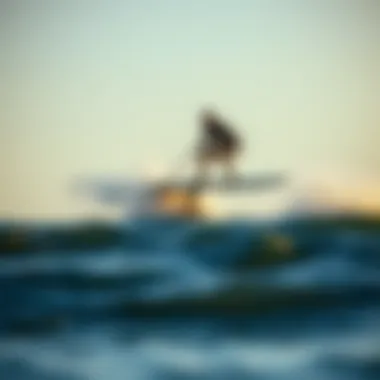
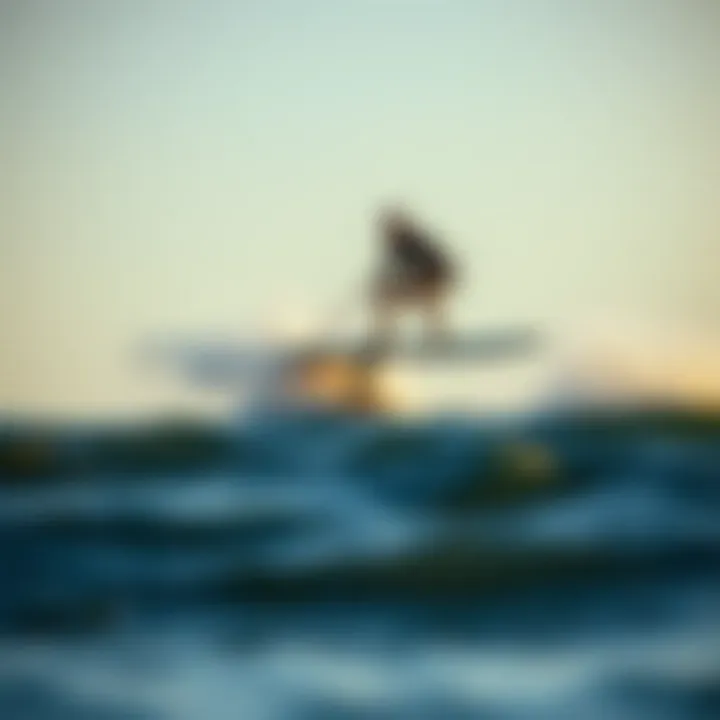
Intro
Hydrofoil surfing has emerged as a unique fusion of adrenaline and technology on the water, attracting attention from skilled athletes and curious newcomers alike. Unlike traditional surfing, where the board rides the waves, hydrofoil surfboards utilize a foil that extends beneath the board, allowing riders to glide above the water's surface. This innovative design opens doors to new experiences, whether gliding over flat waters or catching dynamic swells. With the right gear, techniques, and an understanding of safety, hydrofoil surfing transforms typical water escapades into thrilling adventures.
In the following sections, we will explore the essential gear needed to dive into hydrofoil surfing as well as some critical techniques and tips to keep in mind. Whether you're a seasoned water sports enthusiast looking for your next challenge or a novice excited to learn, this guide is tailored to provide insights that will enhance your hydrofoil surfing experience.
Intro to Hydrofoil Surfing
As water sports innovate, hydrofoil surfing emerges not merely as a trend but as a cultural shift among enthusiasts, adventurers, and professionals alike. The concept of hydrofoils isn't entirely new; however, their application to surfing opens a whole new dimension to riding the waves. Unlike traditional surfing, where one rides on the surface, hydrofoil surfing elevates the rider above the water, creating a unique experience.
Understanding this sport requires a closer inspection of its fundamental elements, which are important not just for learning to ride but also for appreciating the technology behind it. One might wonder, what’s the allure of being up there, gliding above water like a bird? For starters, there’s the joy of experiencing a smoother ride, free of the choppy sensations of rough waves. It offers not just adrenalin, but also an escape, a kind of dance with nature that demands skill and respect.
Hydrofoil surfing invites a diverse array of participants—from seasoned kiteboarders to curious beachgoers—allowing anyone with a zest for exploration to join in. This sport bridges the gap between traditional ocean festivities and modern technological advancements.
A key aspect is its accessibility; contrary to some misconceptions, anyone with basic surfing skills can transition to this exhilarating new form of surfing with the right guidance. This article delves into techniques and gear tailored to aid in that transition, empowering both novices and veterans to find their footing in hydrofoil surfing.
In the broader scope, understanding this sport reveals its implications for the future of water sports: a blend of skill, innovation, and environmental consciousness, making hydrofoil surfing not just a pursuit of thrills, but an integral part of an evolving sporting landscape.
"Hydrofoil surfing isn't just about catching waves; it's about catching the very essence of ocean energy and riding it in a way that feels like flying through water.”
The importance of this introduction lies in gearing you up for a profound journey through the mechanics, techniques, safety, gear selection, and future of hydrofoil surfing. Each section builds upon the last, creating a well-rounded perspective of what makes this sport both exciting and worthy of your time and energy.
The Mechanics of Hydrofoils
Understanding the mechanics of hydrofoils is essential for anyone looking to dive into the thrilling world of hydrofoil surfing. Hydrofoils are not just a fancy addition to a surfboard; they dramatically change how a rider interacts with water, enabling a smooth, almost gliding feeling at higher speeds. The dynamics at play involve physics that might seem daunting at first, but breaking it down reveals how the design and function of these components work together to create an exhilarating riding experience.
A hydrofoil consists mainly of three components: the foil itself, the mast, and the board. Each of these elements plays a critical role in how effectively the rider can harness the power of waves or wind.
How Hydrofoils Work
The fundamental principle behind hydrofoils is rather simple: lift. When water flows over the specially shaped wings—referred to as foils—the flow creates lift due to differences in pressure above and below the wing. This lift raises the board above the water surface, reducing drag and allowing for smoother and faster gliding across the water. The key here is to maintain optimal speed and angle to keep a stable flight, allowing riders to carve turns without losing that exhilarating sensation of flying.
The moment a rider stands on the board and engages with the foil, they become a part of an intricate dance between gravity, buoyancy, and lift. Getting this balance right is essential, as missing it can lead to crashes or an abrupt return to water. Hydrofoils require practice and patience, but mastering them opens up a whole new realm of surfing possibilities.
Components of a Hydrofoil
Foil
The foil is the heart of the hydrofoil setup. Each foil exhibits a specific shape and design that contributes to its overall performance in the water. A well-designed foil will provide adequate lift with minimal drag, which is important for a smooth ride. Riders should consider the surface area and aspect ratio of the foil when choosing one for their style and conditions. Generally, a larger surface area results in more lift, which is perfect for beginners, whereas a smaller foil might cater to experienced riders looking for speed and responsiveness. However, larger foils can feel cumbersome in high winds, making the balance of size and agility significant in the selection process.
Mast
The mast serves as the connection between the foil and the board, holding the foil at an optimum height above the water. This component's material and length vary, with options like aluminum, carbon fiber, or composite materials, each offering different advantages. A longer mast can help with more stability and speed, allowing the rider to navigate the water more effectively. However, a longer mast can also make it easier to catch unwanted waves and cause the rider to fall. Thus, choosing the right mast length is crucial, especially depending on prevailing water conditions.
Board
When it comes to boards, these are specially designed to accommodate the hydrofoil and adjust weight distribution accordingly. Boards come in various shapes, but a fundamental characteristic is that they need to be sturdy enough to handle the foil’s forces without compromising performance. The material—be it foam, fiberglass, or a hard alternative—affects buoyancy and resilience. Many riders prefer shorter boards for better maneuverability, while those starting out might choose longer options for stability. Ultimately, the right board will enhance the overall experience, enabling riders to exploit the hydrofoil's capabilities to the fullest.
"Mastering hydrofoil surfing is about understanding the intricate relationship between speed and control. The mechanics at play create a unique riding experience that transcends traditional surfing."
With a solid grasp of these mechanics and components, riders can significantly improve their skills and enjoyment in hydrofoil surfing. This understanding paves the way for honing techniques and scenarios that are critical as they progress in this dynamic and rapidly evolving sport.
Techniques for Hydrofoil Surfing
Hydrofoil surfing, an innovative mix of traditional surfing and cutting-edge technology, demands a unique set of skills and techniques for success. Mastering these techniques not only enhances the riding experience but also ensures safety and improved performance on the water. Understanding the nuances of balance, paddling, and maneuvering can transform a novice into a seasoned rider more quickly than many expect. Let’s break it down step by step.
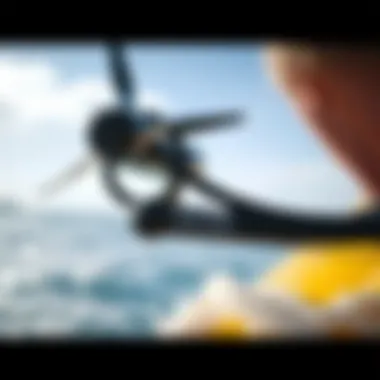
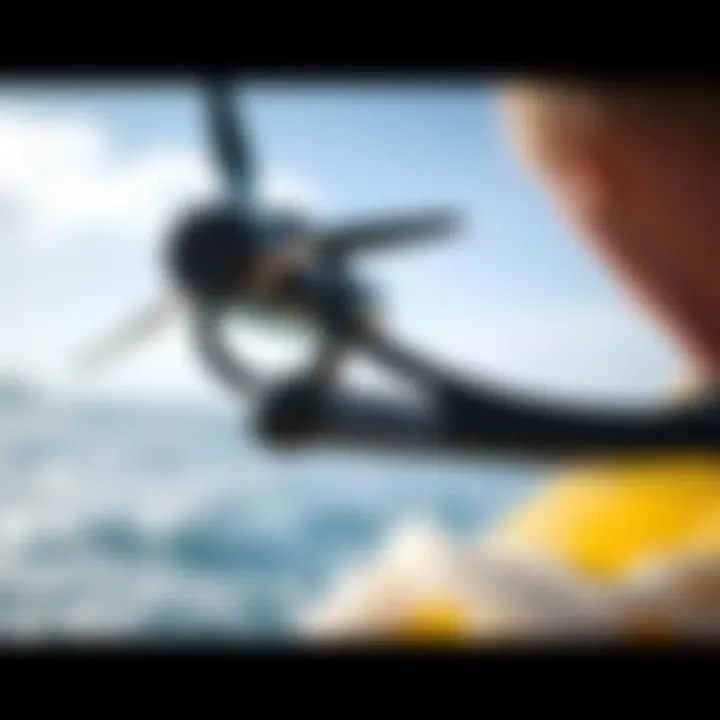
Balance and Weight Distribution
Achieving the right balance on a hydrofoil board is like walking a tightrope; even the slightest misstep can send you tumbling into the water. Here, weight distribution plays a pivotal role. Riders should position their weight centrally, with a slight forward lean to lift the foil above the water while avoiding "nose dives". Often, you'll hear pro riders mention how a simple shift in the feet—putting more weight toward the back—can alter one’s trajectory. This balance isn’t just crucial for lifting off the water but also for maintaining control once airborne. Practicing on land through exercises that mimic surfing motions can build muscle memory necessary for that perfect balance on the board.
Paddling Techniques
Paddling might seem straightforward, but effective hydrofoil paddling requires a thoughtful approach. Instead of frantically thrusting your arms, smooth and even strokes toward the front matter most. Kiteboarders, for instance, will find this serves them well as they are used to similar movements. Angling the paddle at around thirty degrees can generate more forward thrust, making it easier to catch waves. Moreover, adding a bit of momentum during the paddling phase helps to lift the board more easily once you start to pump it. Riders often practice their paddling skills in calm waters to perfect this essential technique.
Getting Up on the Hydrofoil
Transitioning from the prone position to standing on the hydrofoil is a skill set of its own. When you’re ready to make that leap, it’s all about timing and technique. To rise gracefully, kick with your back leg as you pull yourself up, distributing your weight evenly as your feet hit the board. This will help ensure the foil engages properly with the water and gets you airborne smoothly. It can feel like a dance--moving fluidly rather than relying on brute strength. Practicing this maneuver in shallow waters or on calm days can build confidence and technique without the anxiety that comes with dealing with larger waves.
Turning and Maneuvering
Once airborne, turning becomes an art. Utilizing an edge-to-edge technique can provide sharp and responsive maneuvers. As you turn, shift your weight toward your heels or toes depending on the intended direction. This weight transfer not only helps control the climb and descent of the foil but also contributes to smoother, seamless transitions. Many instructors recommend practicing small turns before attempting more aggressive carves. The more attuned you become to your board's responses, the better your handling will feel.
Common Mistakes to Avoid
Even seasoned riders can fall prey to basic errors that can disrupt their hydrofoil experience. Here are a few pitfalls to watch for:
- Too Much Weight Forward: Leaning too far forward can cause the nose to dive, leading you straight into the water.
- Inconsistent Paddling Speed: Quick bursts and then slowing down can throw off your rhythm—aim for steady, smooth motions.
- Not Engaging the Foil: Failing to pump properly or engage the foil correctly often leads to frustrating nosedives.
- Rushing Turns: Prematurely leaning into turns can result in losing balance or control, so practice makes perfect.
Taking the time to learn and perfect these techniques is crucial for anyone looking to explore the exhilarating world of hydrofoil surfing.
Incorporating these skills will not only make the experience more enjoyable but also provide a solid foundation for tackling advanced maneuvers in the future.
Safety Considerations
When it comes to hydrofoil surfing, safety should be at the forefront of any enthusiast's mind. This sport, while exhilarating, comes with its set of risks due to the nature of high speeds and the equipment involved. Prioritizing safety can significantly reduce the chances of accidents and injuries, allowing riders to focus on the thrill of gliding above the water.
Safety Gear Essentials
Helmets
One of the most critical components of safety gear is the helmet. Helmets designed for hydrofoil surfing are not just ordinary headgear; they often incorporate features like reinforced shells to withstand impacts against both water and hard surfaces. A good helmet can protect against serious head injuries that can stem from wipeouts or collisions with equipment. The best choices are lightweight and comfortable, ensuring that they don't hinder movement. Some models come with removable liners, making cleaning a breeze. However, it's crucial to find a snug fit; otherwise, it might slip during a fall, negating its protective benefits.
Wet Suits
Wet suits are essential for maintaining body temperature while riding in cooler waters. These suits insulate the body, providing warmth as you glide across the waves. They come in different thicknesses, allowing the wearer to choose one suited for the water temperature. A well-fitting wet suit not only keeps you warm but also acts as a protective layer against scrapes and minor injuries. While some might find them a bit restrictive at first, many riders appreciate the buoyancy and comfort they provide once accustomed. Ultimately, investing in a quality wet suit pays off by prolonging time spent in the water and enhancing overall enjoyment.
Impact Vests
Impact vests offer another layer of protection, particularly for your torso. These vests are designed to cushion blows sustained from falls, reducing the risk of rib fractures or bruises during sudden impacts with the water. The benefit of wearing an impact vest is that it provides some floatation, which can help in keeping a rider afloat after a fall. Many riders find them comfortable enough to wear throughout their sessions. Nonetheless, they can feel bulky at times, especially for those who prefer freedom of movement. Choosing a vest that is both protective and streamlined is essential to balance safety with performance.
Understanding Local Conditions
Grasping the local surfing conditions is vital for a safe hydrofoil surfing experience. Each surf spot comes with unique characteristics, including wave size, current strength, and underwater hazards. Ignoring these elements can lead to dangerous situations. It's advisable for riders to take some time observing the conditions before hitting the water. Checking local forecasts, talking to other surfers, and being aware of any warning signs around the beach can be immensely helpful.
Emergency Protocols
Having a plan for emergencies can make all the difference during a hydrofoil surfing session. Riders should familiarize themselves with emergency protocols, including what to do if someone gets injured or if a rider gets separated from their board. It might be worthwhile to carry a signaling device like a whistle or an emergency flotation device. Creating a buddy system where riders keep an eye on each other can also offer an extra layer of safety. In case of severe accidents, knowing the quickest route to shore or how to signal for help is crucial. Being prepared minimizes risks and enhances the enjoyment of a thrilling sport like hydrofoil surfing.
"Safety isn’t just a priority; it’s the foundation of enjoying the ride."
Choosing the Right Hydrofoil Gear
Selecting the appropriate hydrofoil gear is crucial for both performance and enjoyment in hydrofoil surfing. Each component, from the board to the foil itself, plays a pivotal role in how you ride. A mismatch in equipment can result in frustration for novices and superior riders alike. It's essential to understand the differences among various types of boards and foils, especially since advancements in technology continue to evolve this sport.
When choosing your gear, consider elements like your skill level, wave conditions, and personal style. The right setup not only enhances your riding experience but can also greatly influence your learning curve. Ultimately, the right gear leads to better balance, improved technique, and a deeper integration with the water beneath you.
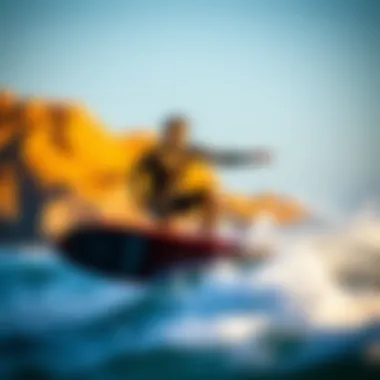

Types of Hydrofoil Boards
Soft-Top Boards
Soft-top boards are gaining traction among beginners and even seasoned riders for a few reasons. Firstly, they are forgiving. The softer surface reduces the chances of injury when falls occur—a common part of learning to ride on a hydrofoil. These boards also offer a level of buoyancy that helps new surfers catch waves with less effort.
The key characteristic of soft-top boards is their cushioned surface. This feature makes them appealing for those just getting their feet wet in the sport. While they might sacrifice some performance compared to harder boards, they allow for a more confident ride, especially in choppy or unpredictable conditions.
That said, they might not respond as well in advanced maneuvers or high-speed situations compared to their tougher counterparts. When it comes to stability and ease of control, however, the soft-top boards stand out as a solid choice for starters.
Epoxy Boards
Epoxy boards are another popular option, particularly noted for their lightweight construction and durability. These boards are made from an epoxy resin, which provides high strength and reduces weight. The key characteristic of epoxy boards is their ability to slice through the water smoothly, making them a favorite among more experienced riders.
One unique feature of epoxy boards is their responsiveness. They often allow for quick turns and transitions while maintaining performance in more challenging waters. This makes them a beneficial choice for those looking to grow their skills and experiment with various techniques.
On the downside, they can be more prone to damage if not handled carefully, and the cost generally runs higher than soft-top boards. For those who are committed and serious about hydrofoil surfing, investing in an epoxy board can clearly pay dividends in performance and enjoyment.
Selecting the Right Foil
When it comes to selecting the right foil, it's important to take into account the size and shape tailored to your riding style and ability level. Choosing a larger foil can offer more lift, providing a more stable experience, particularly for beginners. Conversely, a smaller foil typically results in less drag, suitable for experienced riders who prefer speed and agility. It’s advisable to test different foils before making a decision, as the right fit can greatly influence your progression in the sport.
Brand Comparisons
Popular Brands
Some well-known brands dominate the hydrofoil surfing market, such as Lift and Slingshot. These brands are recognized for their high-quality materials and performance-driven designs. Their key characteristic is an established reputation for innovation, often leading the way in product development.
These brands have extensive product lines, allowing riders to choose from various options tailored to specific skill sets and environmental conditions. Additionally, they often provide reliable customer support and warranty services. The downside? Pricing can be on the higher side, which might not appeal to everyone.
Emerging Brands
In contrast, emerging brands like Jobe and GoFoil have been catching the eye of enthusiasts looking for something outside the mainstream. These brands are crafting creative solutions and often provide a more affordable range of gear. The key characteristic of emerging brands is their commitment to experimenting with new designs and materials, which can often lead to unique performance advantages.
The downside, however, could be a lack of extensive user reviews or proven track records, making it harder for newcomers to choose confidently. Nevertheless, exploring these options may yield rewarding finds for riders seeking a more personalized experience.
"One rider's loss of stability may well be another rider's opportunity for growth."
When considering gear, remember that personal preference and comfort rank higher than industry reputation alone. Selecting the right hydrofoil gear is about what feels right to you and fits your unique style and conditions.
The Environmental Impact of Hydrofoil Surfing
Hydrofoil surfing has sparked a wave of excitement among water sports aficionados, but like any trend in outdoor activities, it comes with its own set of environmental considerations. Understanding the ecological implications of hydrofoil surfing is crucial as the sport gains traction. This not only fosters respect for the environment but also ensures the sustainable enjoyment of these waters.
Sustainable Practices
Embracing sustainable practices is not just a choice for hydrofoil surfers—it's a necessity. Here are a few key practices:
- Eco-conscious Materials: Many manufacturers are now looking into using recycled or sustainable materials for hydrofoil equipment. Boards made from eco-friendly epoxy resins and recyclable foils are rising in popularity. This ensures that when the equipment reaches the end of its life, it doesn’t contribute to landfill waste.
- Educating the Community: Surfers have a unique position to contribute to environmental health, making it essential to engage in community cleansing events or participate in beach clean-ups. By working together, the surf community can actively reduce plastic and other waste in ocean environments.
- Quieter Motors for E-Foils: Electric hydrofoils, or e-foils, benefit from advances in technology that minimize noise pollution. This is beneficial for marine life, reducing disturbance to sea creatures, especially those sensitive to sound.
"Choosing sustainable gear not only enhances the surfing experience but also leaves a lighter footprint on our planet."
Ecosystem Considerations
Hydrofoil surfing involves unique interactions with aquatic ecosystems. Being mindful of these interactions can help preserve ocean health for future enthusiasts. Here are some considerations:


- Wildlife Interactions: Surfers might occasionally find themselves in proximity to marine wildlife. It's crucial to maintain a respectful distance. Encounters with dolphins or other sea creatures should be cherished without disturbing their natural behavior.
- Wave Patterns and Sediment: Straddling the line between performance and environmental ethics, surfers should observe how their actions impact wave patterns and sediment movements. Hydrofoiling reduces direct impact during riding but can still affect sensitive areas like reefs or sandbanks.
- Marine Protected Areas: Many coastal regions have designated marine protected areas (MPAs) where human activity is restricted to preserve marine life and habitats. Surfers must be aware of these zones and respect their boundaries to minimize ecological disruption.
By integrating these factors into the way they surf, enthusiasts can ensure that hydrofoil surfing remains an enjoyable pursuit while safeguarding the very waters that provide this exhilarating experience.
The Rising Popularity of Hydrofoil Surfing
Hydrofoil surfing has recently seen a meteoric rise in popularity, capturing the attention of water sports enthusiasts worldwide. This surge can be attributed to several factors, including the thrill of flying above the water, the advancements in technology that make gear more accessible, and the increasing visibility of the sport through social media platforms and events.
Hydrofoil surfing differs from traditional surfing in that it allows riders to glide above the surface, reducing drag and enabling smoother rides even on choppy waters. This unique aspect not only appeals to seasoned surfers looking for a new challenge, but it also draws in newcomers eager to experience something fresh. It’s no wonder that surf schools are starting to include hydrofoiling in their curricula, as it offers a different kind of adrenaline rush.
Another compelling factor in the growing excitement around hydrofoil surfing is the variety of gear available. Companies are increasingly developing lightweight and user-friendly hydrofoil boards that cater to all skill levels. This means that even those who have never set foot on a surfboard can give hydrofoiling a shot, further expanding the sport’s demographic.
Demographics of Enthusiasts
The demographics of hydrofoil surfing enthusiasts are remarkably diverse. From young kids eager to embrace the sport to older individuals looking to reignite their passion for the water, hydrofoiling welcomes a wide array of participants.
- Age Range: The age spectrum varies widely. Online forums have enthusiasts ranging from teenagers who are just starting to discover the joy of water sports to retirees looking for a new hobby. This variety is one of the aspects that adds richness to the sport.
- Skills and Background: Interestingly, many new hydrofoil surfers come from different sporting backgrounds. Kitesurfers, windsurfers, and even paddleboarders find hydrofoiling an enticing evolution of their favorite activities. This cross-pollination of skills often leads to dynamic interactions among diverse groups, fostering community.
- Geographic Distribution: Locations known for surfing, such as California, Hawaii, and Australia, are hotspots for hydrofoiling. However, those interested in the sport can now be found in lakes and rivers across the globe, making it a truly international pursuit.
Events and Competitions
As hydrofoil surfing grows, so does the culture and community surrounding it, primarily through events and competitions. Local contests often attract a mix of amateur and professional riders, creating opportunities for everyone to showcase their skills. Notable events, like the Hydrofoil Pro Tour, have started to gain traction and give competitors the chance to shine on larger stages.
- Competitions: Competitive events usually feature various categories so that riders can compete with others who have similar experience levels. This layout encourages participation from newcomers while allowing seasoned riders to compete against peers.
- Showcases and Demos: Throughout the year, different organizations host workshops and demo days to introduce potential new surfers to the gear and techniques of hydrofoiling. These gatherings are often a relaxed way for people to try the sport without the pressure of competition.
As hydrofoil surfing continues to capture interest, both casual riders and hardcore fans are pushing the boundaries of the sport. These developments indicate that hydrofoil surfing has a bright future ahead, ripe with potential for innovation and growth. Each wave or gust of wind holds the promise of a new adventure, and for many, that’s where the excitement lies.
"The future of hydrofoil surfing is not merely about the ride; it's about building a community that embraces all who dare to take to the water."
For more detailed insights into hydrofoil surfing, you can visit Wikipedia or check out related discussions on Reddit.
Future Trends in Hydrofoil Surfing
As hydrofoil surfing continues to carve its niche within the broader landscape of water sports, understanding future trends becomes essential for enthusiasts and potential newcomers alike. This section delves into the technological advancements shaping the sport's trajectory, and what predictions might hold for its evolution. The integration of cutting-edge technology, alongside the sport’s increasing popularity, indicates a promising horizon for hydrofoil surfing.
Technological Advancements
The upcoming wave of hydrofoil surfing will be heavily influenced by technological strides. From materials used in the construction of foils and boards to innovative design enhancements, the landscape is changing rapidly.
- Advanced Materials: Manufacturers are experimenting with lighter and more durable materials, such as carbon fiber and high-modulus epoxy, to improve performance and ease of handling. These materials not only reduce weight but also allow for greater responsiveness on the water.
- Electric Hydrofoils: One of the most exciting developments is the rise of electric hydrofoils. These boards use battery-powered motors to lift riders above the water, providing an experience that can be enjoyed across a broader range of conditions and locations. They open the door for beginners as well as seasoned surfers who wish to ride in flat water or choppy conditions.
- Smart Technology Integration: The possibilities of integrating smart technology into hydrofoil setups are endless. Imagine boards equipped with sensors that provide real-time data on performance metrics, or apps that help users track their rides, analyze performance, and optimize techniques. This level of interaction can dynamically enhance the learning curve for newcomers.
"As technology evolves, so does our ability to enjoy the sport at different skill levels and in various conditions."
Predictions for the Sport
Looking ahead, predictions for hydrofoil surfing suggest a variety of transformative shifts—both culturally and environmentally.
- Broader Accessibility: As more manufacturing companies jump on the hydrofoil bandwagon, prices are expected to become more competitive, making the sport accessible to a wider audience. Casual boarders currently watching from the shore might soon find themselves gliding effortlessly above the waves.
- Environmental Consciousness: There’s a growing movement among enthusiasts advocating for eco-friendly practices in hydrofoil surfing. The future may see stricter guidelines for eco-friendly materials and sustainable practices, ensuring that the allure of this sport doesn’t come at the expense of our oceans.
- Increased Competitions and Community Events: With greater accessibility and interest in the sport, it’s likely we’ll see an uptick in local competitions. These events could foster a strong community spirit, bringing together riders of all levels to share tips, techniques, and camaraderie.
Ultimately, as hydrofoil surfing evolves, it’s clear that the synthesis of technology, accessibility, and environmental stewardship will be key components steering the future of this exhilarating sport.
End
In wrapping up the exploration of hydrofoil surfing, it's essential to recognize the significance this sport holds in the larger narrative of water sports. Hydrofoil surfing is not just a passing trend; it embodies a fusion of technology and skill that elevates the experience of riding waves.
One of the main benefits of hydrofoil surfing is the ability to glide smoothly above the water's surface, which can lead to longer rides and the ability to tackle a variety of conditions that might hinder traditional surfing. This means that whether the waves are lackluster or choppy, riders can still enjoy the thrill of the ocean.
Moreover, as we look at the future of the sport, innovations in hydrofoil design and materials are likely to make these boards more accessible, lightweight, and user-friendly. Enthusiasts can anticipate not only improved performance but also sustainable practices that keep the oceans clean and healthy.
Here are some key points to bear in mind:
- Technological Integration: Advancements in gear will continue to enhance the experience, making it safer and more enjoyable.
- Community Growth: The rising popularity is leading to an increasingly vibrant community, fostering a culture of sharing techniques, tips, and experiences among riders.
- Learning Curve: While it presents challenges, the learning experience of hydrofoil surfing fosters resilience and skill accrual, a rewarding journey for all involved.
As the interest in hydrofoil surfing burgeons, it beckons the attention of kiteboarders, adventure seekers, and sports enthusiasts alike. The continuous push for innovation combined with a focus on safety and sustainability establishes a bright horizon for hydrofoil surfing. It's an exciting time to delve into this unique aspect of water sports, embodying both challenge and reward, and ultimately creating a rich tapestry of experiences that redefine what it means to surf.



